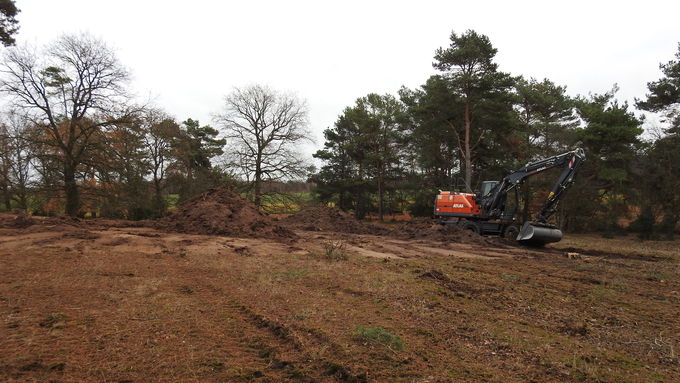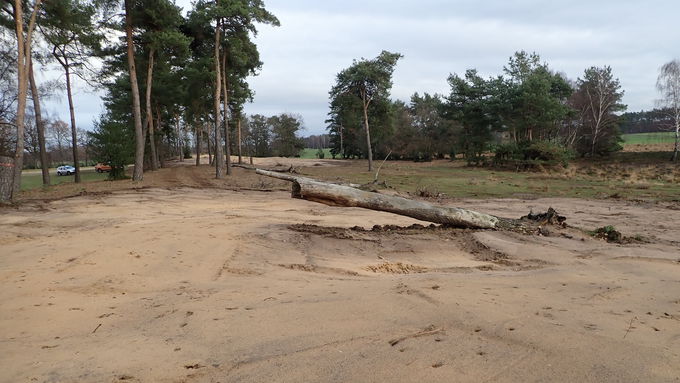The area in the northern ‚Renzeler Moor‘ during implementation © BUND Diepholzer Moorniederung
download picturemain content
Project of the month
#08/2019 UPGRADING OF SAND HABITATS FOR ENDANGERED SPECIES
Restoration of heathlands, inland dunes and small waterbodies in the districts of Diepholz and Nienburg
The ‘Diepholzer Moorniederung’ covers an area of approximately 105,000 hectares in the city triangle of Bremen - Osnabrück - Hanover and includes a variety of protected areas. The area is known in particular for its peat bogs, which are among the most valuable (residual) occurrences in Lower Saxony. It is an important breeding and resting place for many bird species. Numerous rare species of sand habitats, such as the smooth snake (Coronella austriaca), the sand lizard (Lacerta agilis), the natterjack toad (Bufo calamita), the field cricket (Gryllus campestris) and other endangered insect species, find valuable areas of retreat here.
In the past, not only the peat bog sites were heavily affected or destroyed by peat extraction or agricultural use. The formerly sand habitats which were available at a large scale were subject to intensification of use, land conversion or afforestation. The total area of well-developed sand habitats was thereby highly decimated. The nature conservation work of local nature conservation associations, which began several decades ago, in close cooperation with the nature conservation authorities allowed several thousand hectares of bog, wet grassland and sand habitats to be preserved or renatured. In these areas, the success of investment measures can be ensured through continuous landscape management such as sheep grazing.
In order to improve the conservation status of existing sand habitats, create new habitats and stabilize the occurrence of specialized species heathlands, inland dunes and small waterbodies were restored from October to December 2018 in six areas in the districts of Diepholz and Nienburg within the framework of the Integrated LIFE project ‘Atlantic Region DE’ which is funded by the European Union. In addition to extensive earthworks and clearing of woods the material was transported away from the areas to ensure nutrient removal. The action had been developed and was supervised on site by ‘BUND Diepholzer Moorniederung’, organization which oversees the management of the area.• In the northeast of the ‘Renzeler Moor’ (municipality of Varrel in the district of Diepholz), a heavily degraded inland dune was restored. For this purpose, single pines were removed, the shaded areas reduced, topsoil stripped off and open sandy areas were created. This allows for the dispersal of the character species such as whitish hair-grass (Corynephorus canescens) or common shepherd's-cress (Teesdalia nudicaulis) which are present in the surrounding area. The habitat type ‘Inland dunes with open Corynephorus and Agrostis grasslands’ (habitat type 2330) could be improved by opening of strongly moss-covered areas. The smooth snakes and natterjack toads occurring in the area can use the dune as partial habitat. In addition, ground-nesting insect species benefit from the newly created open sandy areas.
- In the ‘Grillenheide’ in the eastern part of the ‘Neustädter Moor’ (municipality of Wagenfeld in the district of Diepholz), the succession with pines and blackberries was pushed back. The succession pressure is particularly high due to the surrounding pine forests and intensive agriculture. Parts of the overaged heathland were mowed. By removing the topsoil, a mosaic of open sandy areas and grown heathland could be created. The measure primarily benefits the habitat type ‘Dry sand heaths with Calluna and Genista (habitat type 2310). In addition, habitat for the field cricket and other ground-nesting insects is improved.
- In the south of the ‘Renzeler Moor’ (municipality of Barenburg in the district of Diepholz), the habitat type ‘Dry sand heaths with Calluna and Empetrum nigrum’ (2320) was restored. Single trees were removed, the overaged heath was mulched with a junk basket and a mosaic of open sandy areas created while preserving the pronounced dune relief. The former sand tapping points were heavily overgrown with bushes and trees. With the renewed clearing, the marsh clubmoss (Lycopodiella inundata) which formerly occurred there may repopulate the area. In wet years, habitats may be colonized by the natterjack toad. Overall, the conservation status of habitat type 2320 could be improved in the area and positive synergies for adapted species were created. At the same time, with regard to the smooth snake, valuable matured stands of heathlands and single trees were preserved as well as hiding places for reptile species maintained.
- In the north of ‘Hohes Moor’ (near Kirchdorf in the municipality of Steyerberg, in the district of Nienburg), an inland dune with sand heaths and grasslands was optimized. Emerging black cherry (Prunus serotina) and wood small-reed (Calamagrostis epigejos) increasingly threatened the well-developed, lichen-rich Corynephorus grasslands and sand heaths. By removing several pines and black cherries as well as growing bushes and stripping off the topsoil, a mosaic of open sandy areas was secured and extended. This has improved the existing habitat types 2310 and 2330. In addition, former excavations at the edge of the dune were cleared and modelled. With the new open clearances and single stump piles, the habitat of the sand lizards and smooth snakes in the area was optimized as well.
- South of the ‘Nördliches Wietingsmoor’ (municipality of Freistatt, joint community of Kirchdorf, in the district of Diepholz), a waterbody and its environment have been restored and developed. An advanced succession had greatly reduced its suitability as spawning ground for the natterjack toad. Therefore, full-grown pines and scrub encroachment were removed, part of the soft-rush (Juncus effusus) was mulched and removed together with the topsoil. Subsequently, a flattened, sunlit riparian zone was modelled. The removed tree stumps were left as wintering quarters for the toads. These measures allow for further development of the area. At the same time, valuable vegetation and dragonfly habitats could be spared.
- Measures were taken in Holzhausen (municipality of Bahrenbostel, joint community of Kirchdorf, in the district of Diepholz) to reopen a sand extraction site. Succession through pines, birches and poplars over a period of about 30 years had led to the absence of open sandy areas. The existing depressions were completely overgrown and rarely water-bearing. Formerly, the area had been populated by the natterjack toad. If the habitat conditions improve accordingly, the area which lies in cultivated landscape can serve as a stepping stone habitat between existing toad populations. Therefore, to restore the habitat, trees and shrubs were cleared, the topsoil was stripped off and open sandy areas and slopes were modelled. Numerous temporary small waterbodies were created. Some structural elements made of trunks and root stumps were piled up in the peripheral areas as quarters for amphibians and reptiles. These measures not only created the necessary conditions for a resettlement by the natterjack toad, but also realized positive synergies for psammophilous insects.





